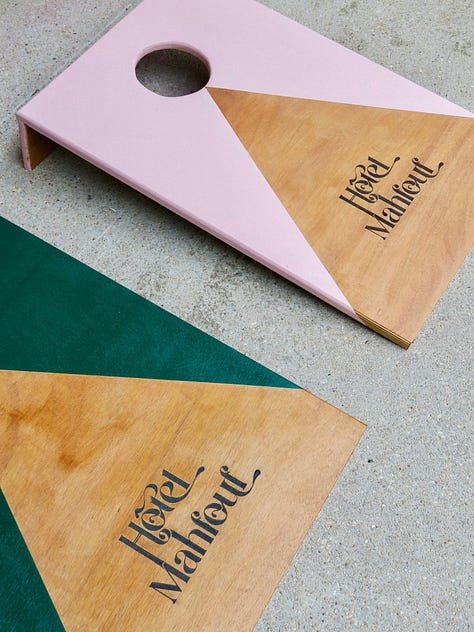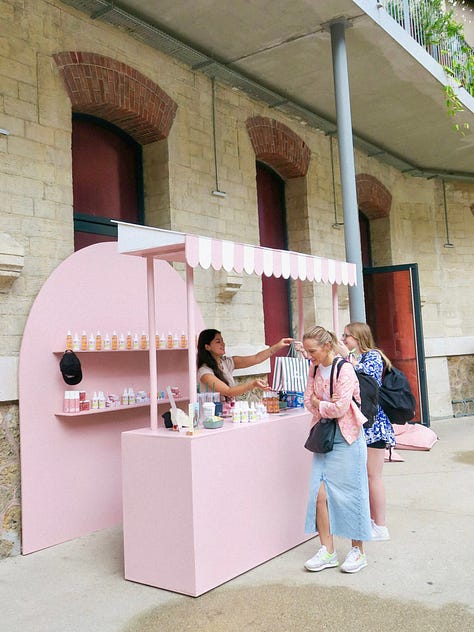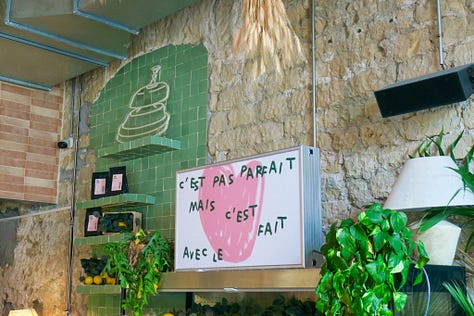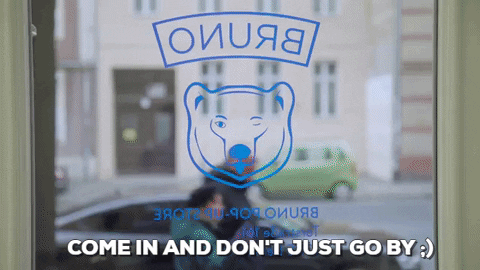💈Can we talk about pop-up events and what they really do for your business?
Let's look into: building brand awareness, engaging customers and sales potential
👋 Hello Branding Revealers. How are you doing today?
Today, we dive into another impromptu branding short, exploring the role of pop-up events in your business. A few weeks ago, an old colleague invited me to her pop-up event showcasing her new venture as a fashion designer. As I observed her navigate her one-evening event, I couldn’t help but think about how these short moments in time—shaped by purchasing routines—can bring immense value to any brand, creative, or entrepreneur. More than that, they can serve as a disruptive statement and a defining part of a brand’s DNA.
Bringing your brand onto people's radar is one of the best moves you can make. You get raw and genuine feedback on the spot—nothing compares to that for growth and improvement. Not every pop-up has the same goal or ambition, especially when you're just starting to build your brand's presence. But once you have a strong, established brand, these events can become powerful magnets for solidifying your reputation.
☕ Grab some tea or coffee and let’s go!
What can a pop-up do for your business?
11 short insights on how to seize this opportunity + takeaways.
Song of the day.
✦ Did you miss the last letter? We talked strategic branding first.
A question of observation:
What can a pop-up event do for your business?
First, a pop-up event is a temporary, often unexpected event that appears in a specific location for a short period, usually a few hours. These events can take many forms. Such as retail shops, restaurants, art installations, and concerts. But also brand activations and awareness campaigns.
We are all consumers of these impromptu events. They cross our paths unexpectedly, we get invited to them, or we stumble upon them while attending other events. Pop-ups create exclusivity. They embody a sense of novelty, attracting new customers and fans within a few hours. They can strengthen existing bonds. But also serve as icebreakers for new connections with audiences.
They have been gaining traction for years, starting in the 1980s and reaching popularity in the early 2000s. They reflect the growing demand for more in-person brand experiences. Here are a few reasons why they have become a powerful branding and marketing tool for long-term growth:
Experiential Marketing – More and more brands want to capitalize on the growing need for community IRL* now more than ever. They recognize the value of creating unique, real-life experiences to engage both new and existing tribes.
Social Media – The online world is saturated with content. People can find it more genuine to confirm their love for a brand through a pop-up event. Founders and business owners can leverage these events for their social media. By sharing behind-the-scenes moments and exclusive new products. And how IRL customers react to their products. It is a complementary loop that serves both the offline and digital worlds of a brand.
E-commerce & DTC Brands – Renting a shop is expensive, especially for young brands. Opening a pop-up can help new online brands create in-person connections without long-term leases. It is a powerful funnel for brands to drive traction towards their online stores.
Pop-ups are open to so many fields – It is not only for Retail & Fashion brands (check out IKEA’s take on the format), Pop-ups expand to food and beverages (food trucks have invaded our routines), entertainment and experiential events (Netflix creates a Stranger Things Experience and Studio Ghibli is a coup de cœur in Paris), and also tech startups and giants (Google and Nike have also set their tones).
*IRL: In real life
Comme des Garçons: one of the first major fashion pop-ups
Tokyo-based brand Comme des Garçons, was co-founded by Japanese stylist Rei Kawakubo. They launched temporary stores worldwide, pioneering the concept. Their guerrilla stores embodied audacity and disruption, making pop-up events a part of their iconic and unconventional DNA.
They use art as a differentiator in their pop-up art stores. They showcase art pieces, performances, and elevate art to the level of their products. Customers don’t just buy clothes, accessories, perfume, and more. They buy an experience of art, a perceived experience that extends to both the store and the clothes. They are always challenging the status quo and shifting perceptions of what art stands for.
11 insights on how to seize this opportunity to grow
1. ⏱️ The timeline and length
A pop-up can last for a few hours, a week, a month, or sometimes even longer. However, the shorter the time frame, the stronger the exclusivity effect. Every event will be different depending on the sector and objectives. But one key benefit is the freedom to decide how long you want to occupy a space and craft a brand experience. You can leverage both your network and passing customers for short and longer stays. Inviting people while also benefiting from the word-of-mouth and buzz around the pop-up in the neighborhood.
2. 🛋️ Be wild, create and experience, craft a world
A pop-up event is an opportunity to showcase your brand values, personality, and flair into a space and in every detail. It is not a random juxtaposition of your brand identity. It is a strategic and playful expression of your brand with a twist and goal. When sharing your products and services, you want to create an experience for your customers. Thinking of creative and playful ways to make the environment more enjoyable. But also aligned, engaging, and open to their stories and feedback. A pop-up event is like a conversation bubble in that sense. It can decode what makes a great space for conversations. It doesn’t need to be expensive; it needs to be effective, welcoming, surprising, and true to your brand’s DNA.
If your brand thrives on feedback loops, focus groups, and involving customers in the process, then craft an experience. One that reflects that brand value. The limit is the budget. But with what you have, you can still create and bring people into your world with all it entails. Thinking of signage, posters, decorations, music, video, live events… you name it!
3. 🙋🏽♀️ First encounter…
A pop-up event is a middle ground. One between what you see on a screen and the real value you experience when you hold the product, try a service, and more. That encounter is pivotal, and first impressions do matter. How you welcome people and how they feel inside the space is crucial. Can they touch the product and test it for themselves? Are you accessible for questions? Is the space designed to encourage bonding? How did you welcome them—with a smile, a drink, or a trigger outside?
4. 💪 Contacts and network reconnecting
Launching your pop-up for the first time is also a great way to bring together people from your network who may have never met before. You become a connector of brands, collaborations, and worlds. A pop-up event is also about the people who join you on this adventure. If you're a seasoned pop-up organizer, you're capitalizing on a growing community of regulars—curious and familiar with your style and personality.
5. 🛍️ How we buy: instant vs. taking our time
Not every pop-up event will result in massive sales. Short-term pop-ups, especially those lasting only a few hours, serve as an introduction. Particularly for new creators and brands, and especially for high-priced products. When you offer medium to premium-priced items and aren't yet well-known in that niche, you welcome people from all walks of life into your space. Some may buy right away if the product meets their criteria—budget, style, value, aesthetics, and more—but for others, it will take time. So, in many cases, your pop-up serves as an appetizer. The more you repeat the experience, the more you can drive sales to your event.
6. 📈 Data and feedback on the spot is market fit
There is nothing more powerful than what your customers say to you on the spot about your products, services, and brand. An opportunity to confirm if the way you share and embody your brand aligns with the perception people have on the outside. Keep your notebook close! Listen to the recurring questions, adjectives, and taglines they use to describe you and your brand. It will help you gauge resonance and interest. But also curiosity and any potential questions or apprehensions. Take quality time in the conversations to listen to their stories. Some will share, and you might get closer to identifying a need in your niche. One you’re already filling or one you may want to position yourself in and bring a solution.
7. 🚀 Can a pop-up launch your bigger vision and brand?



A few years ago, I stumbled upon one of the pop-ups by French influencer Lena Situation (she has a strong and loyal following). Hotel Mahfouf is a fashion and lifestyle brand she created, where every piece tells a story. She took her vision to the next level and created physical extensions of her brand’s personality.
Customers attend these pop-ups not only for the experiences and goodies of the venue but also for the latest collections. She goes all in! And consistently offers experiences that reflect her brand. She also showcases her business, marketing, and community-builder skills.
Today, her pop-up events have birthed a pop-up brand. I quote, " La marque change de murs comme de chemise*, " embodying the constant nomadic life of this brand. Each new venue introduces a whole new dimension, surprising audiences. For Valentine’s Day, they launched an exclusive collection in partnership with Zalando and the Socialclub, complemented by an immersive pop-up event in Paris.
*’’ La marque change de murs comme de chemise ’’: The brand changes walls like shirts.
8. My pop-up story…
My first pop-up event was eye-opening for me, and it even inspired me, giving me a roadmap for understanding how we buy. I wrote about it on my blog. What I learned during that month of art, design, branding, and interacting with people provided strategic insights for progress.
I learned how to think branding before the customer even steps through the door. How to create an experience and tell a story, pieced together by many small moments. How to choose standout pieces and capitalize on them by listening and observing how people navigate your space and what they like the most.
I also learned how to manage time and stock, all while being aware of your location. How to balance a spot that doesn’t bring you the traffic you expected and how to stand out among many other shops, especially if you're the only pop-up in the area. And so much more.
For sure, it’s an experience I’d love to do again—this time with a bigger budget and a concept that can expand within the space!
9. 🔎 Era of screens and the need to meet you live: ‘‘oh, she is human…’’
Everybody is tired of being on screens all day. Even when you're not working, you still find yourself scrolling. Buying digitally has become somewhat erratic. The constant triggers to buy and the never-ending messaging and sales tactics can be overwhelming. That doesn’t mean these things don’t exist, IRL, but when we step outside, we make decisions very differently. We can feel the materials, hear the founders, and read the labels. But also, ask direct questions and follow our intuition on the spot, leading to wiser decisions. The parameters of choice are also challenged. Urgency tactics can be intense IRL, but it’s a different purchasing experience. It’s more intentional to enter one shop rather than another based on our own perceived will. Additionally, pop-up events give us a chance to learn more about the person behind the brand and confirm what we’ve seen online. It's always a good feeling to check things out on the spot and in the moment. It provides us with more information and sensory feedback to help us decide whether to buy now or later.
10. 🌱 I don’t have a product. Can I do a pop-up?
As I researched the topic, I found that the possibilities are limitless. A pop-up can work for a chef, a coach, a creative/artist, or a writer who wants to connect with new customers. It’s also a great tool for nomadic professionals who navigate different communities, regions, and cultures. A pop-up is not only for products and goods. It can also embody ideas. It can apply to actors, writers, and anyone giving live screenings or lectures. I’ve also been thinking about non-profits who want to bring more awareness to their causes and mission.
If you don’t have a product, no problem—you have a service, a skill, a newsletter, or a driven concept! I think that’s the keyword: a concept to deploy.
11. 🧠 Think collective dynamics and support
You can host your pop-up event with other people. By joining a group of brands where everyone shares the space for the duration of the event. This approach pools funds, space, and audiences. Like fairs and markets, you benefit from the people who come for a specific brand, product, or style. These audiences get the chance to discover your brand—and the same goes for the other brands involved. It's an opportunity to showcase a collective and create a broader experience made up of many smaller experiences. Similar to what we see in concept stores and multi-brand retail spaces.
Thinking of pop-ups as a collective adventure can be a great way for new brands to gain community support and leverage. It also serves to strengthen that pop-up "muscle." And yes, it’s not easy to do a pop-up alone—it requires many skills, talent, and emotional support to sustain the event.
💡Branding foresight
There is a whole ecosystem around pop-up shops. Companies even offer done-for-you offer services for various budgets. A whole set of experts are dedicated to helping brands create experiences. It ranges from interior design to scenography, ensuring the closest possible representation of a brand within a space. It must be a treat for architects, designers, and illustrators to dress a space and make it feel alive, reflecting the brand’s DNA. In a nutshell, pop-up events are powerful tools for brand awareness. Getting on the radar of future customers can be life-changing for a brand. Especially if that group resonates with the brand's product, personality, and mission. The gain in visibility, with the right location, the concept, and deployment of the brand’s DNA, can put a brand in the spotlight. But also elevate its reputation. It's not just about increasing sales—it’s about taking the brand to a new dimension. A digital brand and an IRL brand.
Pop-up events push any brand to see things differently, offering live feedback and the opportunity to test products and services while connecting or reconnecting with your people in a playful and engaging way. Pop-up events can be pivotal in your brand’s growth, especially if your brand is ready to claim that space and own it!
Just an idea: Brand sisterhood or brotherhood, league of brands united for a mission…
Sending storytelling vibes 📚
Keva.
If you enjoy the content and believe in what I am building here, consider becoming a paid subscriber. You can also find more ways to support me here.






